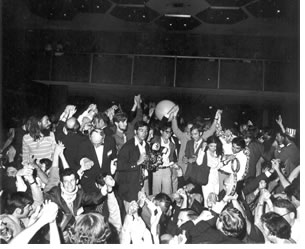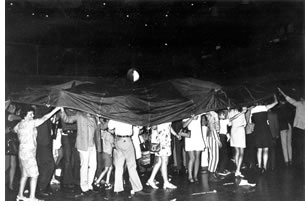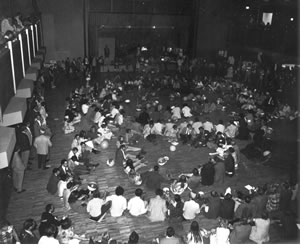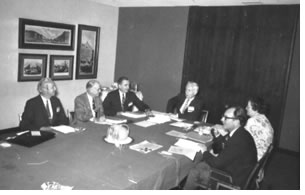

by Andrew Brodie
Smith
The socially turbulent 1960s and early ’70s were a time in the
U.S. when people tested and challenged inherited norms and
verities, and the AIA was not untouched by the spirit and mood of
the moment. Critical national and international events forced the
organization, which for 100 years had a reputation for being civic
minded, to reconsider its standing in the larger society. As social
movements percolated across the country, the AIA took a hard look
at itself and asked fundamental questions about the social role of
professional societies in general and of architects in particular.
Which social ills required the attention of the AIA? Were there
questions of conscience, non-professional in nature, that demanded
that the organization leverage its influence and prestige in
Washington? Was it right for members to ask the AIA to take
positions on issues beyond the expertise of architects and
planners? Did circumstances sometimes require it?
 That
the political winds were shifting and the Institute was somewhat
out of step with progressive America first came into sharp focus
during an address by Urban League President and prominent civil
rights activist Whitney Young Jr. to the AIA 1968 Convention. Young
told delegates that, when it came to the nation’s critical
social issues, architects were “most distinguished” by
their “thunderous silence and complete irrelevance.”
Correct or incorrect in his assessment, Young had taken the gloves
off, and polite discourse no longer was the order of the day when
the social commitment of the profession was in question.
That
the political winds were shifting and the Institute was somewhat
out of step with progressive America first came into sharp focus
during an address by Urban League President and prominent civil
rights activist Whitney Young Jr. to the AIA 1968 Convention. Young
told delegates that, when it came to the nation’s critical
social issues, architects were “most distinguished” by
their “thunderous silence and complete irrelevance.”
Correct or incorrect in his assessment, Young had taken the gloves
off, and polite discourse no longer was the order of the day when
the social commitment of the profession was in question.
Inspired by the line of inquiry opened by Young and influenced by
left-wing, activist campus groups like Students for a Democratic
Society, architecture students also became more political in the
late ’60s, sometimes clashing with established professionals.
Students who had addressed prior AIA conventions had been brief and
deferential; now their tone was more strident. AIA Students
President Taylor Culver, an African-American, spoke to the 1969
convention in Chicago. Culver reassured nervous members, who had
seen on television the violent student protests nine months before
at the Democratic Convention held in the same city, that
architecture students weren’t about to tear down curtains or
throw chairs. Nonetheless, they would have their voices heard on
pressing national and professional issues. Angry about the
AIA’s neglect of some critical social problems, Culver
occasionally bordered on the confrontational while addressing the
gathered professionals: “What you as a generation have given
us, we are not exactly appreciative of.” And then later:
“I think you’ve failed and in fact if you turn your
backs, you will continue to fail.”
Expertise or conscience?
Civil rights, women’s liberation, political corruption,
the student’s movement, inflation, environmental concerns, the
energy crisis, of all the exploding social issues of the day that
occupied the AIA, none was more divisive than the Vietnam War. In
part, the division stemmed from a philosophical difference among
members as to whether an organization of architects should voice an
opinion on such a complex geopolitical issue. Some members felt
that Vietnam fell well outside the expertise of the profession and
that coming out officially against the war would squander the
influence and prestige of the Institute.
Others argued that it was simply wrong for the AIA to stay on the
sidelines of an issue of such national moral import. Moreover, they
believed that the organization could not effect change in the
domestic areas clearly within its purview—public housing, the
environment, energy, transportation, and design—while the
war’s price tag threatened funding for programs at home. As
Vietnam divided American society, it too split the AIA. The
Institute struggled with this internal conflict for years,
ultimately to no satisfactory answer.
1969: Commitment to “a humane
environment”
When, in 1966, the first anti-war rumblings were heard on the AIA
convention floor, U.S. combat troops (as opposed to military
advisers) had been in Vietnam for little more than a year. During a
discussion of other matters, Sidney Katz, AIA, rose to speak:
“The older order status quo is sitting very comfortably by
while the younger men are being picked off one by one and sent off
to a war to die and we certainly have not done enough to protest
this … War is hell; the Vietnam situation is hell, and it must
be removed at once.”
 Three
years later, it was clear that these were the sentiments of many in
the architecture community. Chastened by the Whitney Young speech
the year before, pushed by its more politically progressive members
and students of architecture, and inspired by the social movements
building around them, the AIA took perhaps the most public stand in
its history on the pressing social problems of the day, passing
what it called the “National Priorities”
resolution.
Three
years later, it was clear that these were the sentiments of many in
the architecture community. Chastened by the Whitney Young speech
the year before, pushed by its more politically progressive members
and students of architecture, and inspired by the social movements
building around them, the AIA took perhaps the most public stand in
its history on the pressing social problems of the day, passing
what it called the “National Priorities”
resolution.
The resolution pronounced the AIA’s commitment to a
“humane environment,” to finding the money and political
will “needed to erase the shame of urban America.” And,
while not mentioning Vietnam by name, the resolution asserted
“that we have neither unlimited wealth nor wisdom, and that we
cannot sensibly hope to instruct other nations in the paths they
should follow when we are increasingly unable to demonstrate that
we know how to maintain a viable society at home.” As if
announcing that it had emerged from what Whitney Young had called
its “thunderous silence and complete irrelevance,” the
AIA later ran quotes from the resolution in major dailies
throughout the country.
Although the positions laid out in the National Priorities
resolution represented an unprecedented articulation of political
views for the AIA, they did not go far enough in the estimation of
many in the organization, particularly liberal members of the
Boston Society of Architects, the New York Chapter, and the AIA
Students. These groups as well as others made up an opinionated and
substantial faction within the organization that wanted it to come
out explicitly against the Vietnam War. Those persons holding the
most power nationally, especially the AIA Board of Directors, felt
differently. Taking an explicit and public anti-war position would
risk poisoning the waters between the AIA and the Nixon
Administration, hampering the effectiveness of the organization to
influence federal policy in areas that were more directly related
to the architecture profession.
1970: Increasing opposition
When the AIA convention convened in the summer of 1970,
public sentiment had turned increasingly against the war. The
courts martial of U.S. soldiers accused of responsibility for the
My Lai massacre had dominated the national news for much of March.
The invasion of Cambodia in late April sparked protests and riots
throughout the country, leading to the National Guard killing four
students at Kent State. It was in this environment that the AIA
Resolutions Committee was peppered with proposals for anti-war
resolutions from members and chapters wishing for consideration of
the issue on the convention floor. The Resolution Committee
consolidated these suggestions into one supplemental resolution,
which, for the most part, reiterated the sentiments of the National
Priorities resolution of 1969. While still making no specific
mention of Vietnam, the supplemental resolution did urge “the
President and Congress to reduce our military commitments and involvements
abroad to the absolute minimum consistent with our
nation’s security.” [italics added] This was a clear
attempt to appease the doves.
A call for reduced military commitments, however, wasn’t about
to placate the most anti-war of members. Stymied by the Resolutions
Committee and the leadership of the AIA, they introduced an
amendment on the floor. Member Richard Stein of New York read it to
the assembled: Resolved, that “the President and Congress of
the United States remove our military forces from Southeast Asia in
accordance with the schedule set up in the McGovern-Hatfield
Amendment, that is, immediately withdraw from Cambodia and complete
withdrawal from Vietnam by June 1971.” The issue the AIA
leadership had been so careful to avoid was now open for
consideration.
 For
many influential people in the Institute, Stein’s amendment
was anathema. Such a direct repudiation of Nixon’s foreign
policy was to their way of thinking a foolhardy course. Relations
between the AIA and the Nixon Administration were cordial. Just
prior to the convention, Nixon had written a letter to then AIA
President Rex Allen in which he expressed his “warmest
admiration” for the AIA’s work on “the urgent needs
in communities across the country” and for its “civic
awareness and desire for human betterment.” Respect and
friendship between the White House and the Institute had ebbed and
flowed throughout the years and could never be assumed. If Nixon
was receptive to the organization, this represented an opportunity
that needed to be delicately leveraged. Outright support of a cease
fire on the part of the AIA would likely damage relations. Why
squander the prestige and goodwill of the Institute in Washington
on a foreign policy issue that architects were unlikely to impact
either way and that was beyond their expertise anyway?
For
many influential people in the Institute, Stein’s amendment
was anathema. Such a direct repudiation of Nixon’s foreign
policy was to their way of thinking a foolhardy course. Relations
between the AIA and the Nixon Administration were cordial. Just
prior to the convention, Nixon had written a letter to then AIA
President Rex Allen in which he expressed his “warmest
admiration” for the AIA’s work on “the urgent needs
in communities across the country” and for its “civic
awareness and desire for human betterment.” Respect and
friendship between the White House and the Institute had ebbed and
flowed throughout the years and could never be assumed. If Nixon
was receptive to the organization, this represented an opportunity
that needed to be delicately leveraged. Outright support of a cease
fire on the part of the AIA would likely damage relations. Why
squander the prestige and goodwill of the Institute in Washington
on a foreign policy issue that architects were unlikely to impact
either way and that was beyond their expertise anyway?
Board member and future (1972) AIA President Scott Ferebee, FAIA,
rising in opposition to Stein’s anti-war amendment, worried
out loud about what effect its passage might have on the fate of
the AIA’s efforts to get a professional architect appointed to
the position of Architect of the Capitol for the first time in 100
years. Nixon certainly was capable of retaliating by passing over
the Institute’s choice for the job, AIA Vice President George
White, FAIA. Opposition to Stein’s amendment may have been
partisan in nature and not exclusively born of a desire for the
Institute to pick its battles judiciously, evidenced by
Ferebee’s open support for Nixon’s Vietnam strategy.
“A number of us believe that the president’s action in
Cambodia was designed to get us out of Southeast Asia,” he
said on the floor of the Convention, “and it will have that
effect.”
Thanks in part to Ferebee’s arguments, the delegates defeated
the Stein amendment and passed the resolution that contained the
less confrontational language urging the reduction of military
commitments abroad. The issue, however, was not about to go away
and reared its stubborn head again during the following convention
in 1971.
1971: Boston and New York try
again
Not taking defeat lying down, The Boston Society of
Architects sent in a resolution to the National Convention the next
year, approved by a majority of its membership, which called for an
immediate end to the “massive destruction of the natural and
human environment in Indo-China.” Consistent with AIA
leadership’s reaction to a similar amendment the year before,
no such resolution made it out of committee. However, once again,
due to the politicking of the Boston architects and others, the
Resolution Committee took a small step in the direction of the
doves and introduced, now for the third time, a resolution
reaffirming the position of the AIA on national matters.
This time, the resolution was called the “Omnibus Resolution
on National Priorities,” and its authorship was credited to
the Boston Society of Architects, the New York Chapter, the AIA
Board of Directors, and the Resolutions Committee. The Omnibus
Resolution contained essentially the same general provision
regarding military commitments of the U.S. as expressed in 1970
with a slight modification, the word “accelerate” was
added, to indicate an added sense of urgency: President and
Congress should “accelerate the reduction of our
military commitments and involvements abroad [italics added].”
The resolution also urged “the rebuilding of areas ravaged by
war, most specifically the Indo-China area.”
 Like
the year before, the most anti-war members found the new Omnibus
Resolution on National Priorities lacking for not specifically
calling for an end to the Vietnam War, and like the year before, a
member from New York (Mr. Frost), introduced an amendment from the
floor with stronger and more specific anti-war language. “The
recent disclosure in The Pentagon Papers of how our war policy was
made makes us more ashamed than ever of what has been going on so
long in Indo-China,” he said and then moved that the AIA
“urge the President to promptly initiate a unilateral and
total cease-fire.”
Like
the year before, the most anti-war members found the new Omnibus
Resolution on National Priorities lacking for not specifically
calling for an end to the Vietnam War, and like the year before, a
member from New York (Mr. Frost), introduced an amendment from the
floor with stronger and more specific anti-war language. “The
recent disclosure in The Pentagon Papers of how our war policy was
made makes us more ashamed than ever of what has been going on so
long in Indo-China,” he said and then moved that the AIA
“urge the President to promptly initiate a unilateral and
total cease-fire.”
Debate erupts on the floor
Mr. Bailey Ryan, AIA, (Kentucky): “Mr. President, I
don’t think there’s a man [sic] in this room that
disagrees with what is said in the resolution … We all feel
deeply about this; our guts are torn out about it. But I have seen
this war fought on this convention floor for three years with the
same resolution, exactly worded approximately the same way, and
every year we have the same debate and end up defeating it all
because the AIA are architects and we’re not militarists and
we’re not at all about showing the president of the U.S. how
to run the government on some other level not related to
architecture.”
Joe Siff, president of the AIA Students: “The amendment to
this resolution was brought up at a number of student caucuses and
I would like, therefore, to express the feeling of the majority of
the students here … Their feeling is that we are not
architects first, we are citizens first, and therefore it is wholly
appropriate to debate this issue on the floor of this
convention.”
Mr. Boone, member of the Board of the AIA: “At the risk of
being called a ‘hawk,’ I will point out this [a cease
fire] is totally unrealistic and impossible from a military
standpoint, and if someone passed such a resolution when those of
us were fighting World War II, I don’t think when we came home
we would have joined the AIA.”
 Did we, or
didn’t we?
Did we, or
didn’t we?
After everyone had their say, the vote was taken. The
substitute resolution passed 69 to 55. After three years and much
acrimony, the AIA had finally taken an official position against
the Vietnam War. Or had it?
Upon announcement of the passage of the amendment, a delegate from
Southern California called for a written ballot on the question,
under which each delegate’s vote would be properly weighted to
take into account the number of members he or she actually
represented. The call for the written ballot received the required
vote of one third of the delegates. There would be a second vote.
Under the weighted ballot, the anti-Vietnam War resolution was
roundly defeated 365.81 to 736.61. The AIA had taken an anti-war
position, at least for a few minutes, and then took it away.
Moreover, the Convention took out the plank calling for the
rebuilding of war-torn Indochina. Mr. Virden of Mississippi, member
of the Board of Directors representing the Gulf States Region,
argued for the plank’s removal: “I find it singularly
amusing that in this whole resolution no mention is made of
veterans, of children of men that were killed over there, of
mothers and fathers and so forth, and yet we want to spend all the
money to take care of Vietnam.”
The issue resolves
itself
The next year would see yet another attempt to pass an
anti-Vietnam-War resolution. This one expressed “profound
concern … over the extension of the war.” However, with
no National Priorities resolution in 1972 on which to tack such an
amendment, those who offered the resolution needed a two-thirds
majority vote to get the Convention to consider it. They failed to
get the votes needed for consideration.
In January of 1973, the U.S., South Vietnam, and North Vietnam
signed the Paris Peace Accords, ending America’s combat role
in war and silencing the official AIA debate on the issue. The
course of events had resolved the problem for the Institute. The
organization would remain officially silent about the war. This was
as it should be according to some. To others it was a failure of
moral courage.
Copyright 2005 The American Institute of Architects. All rights reserved. Home Page

